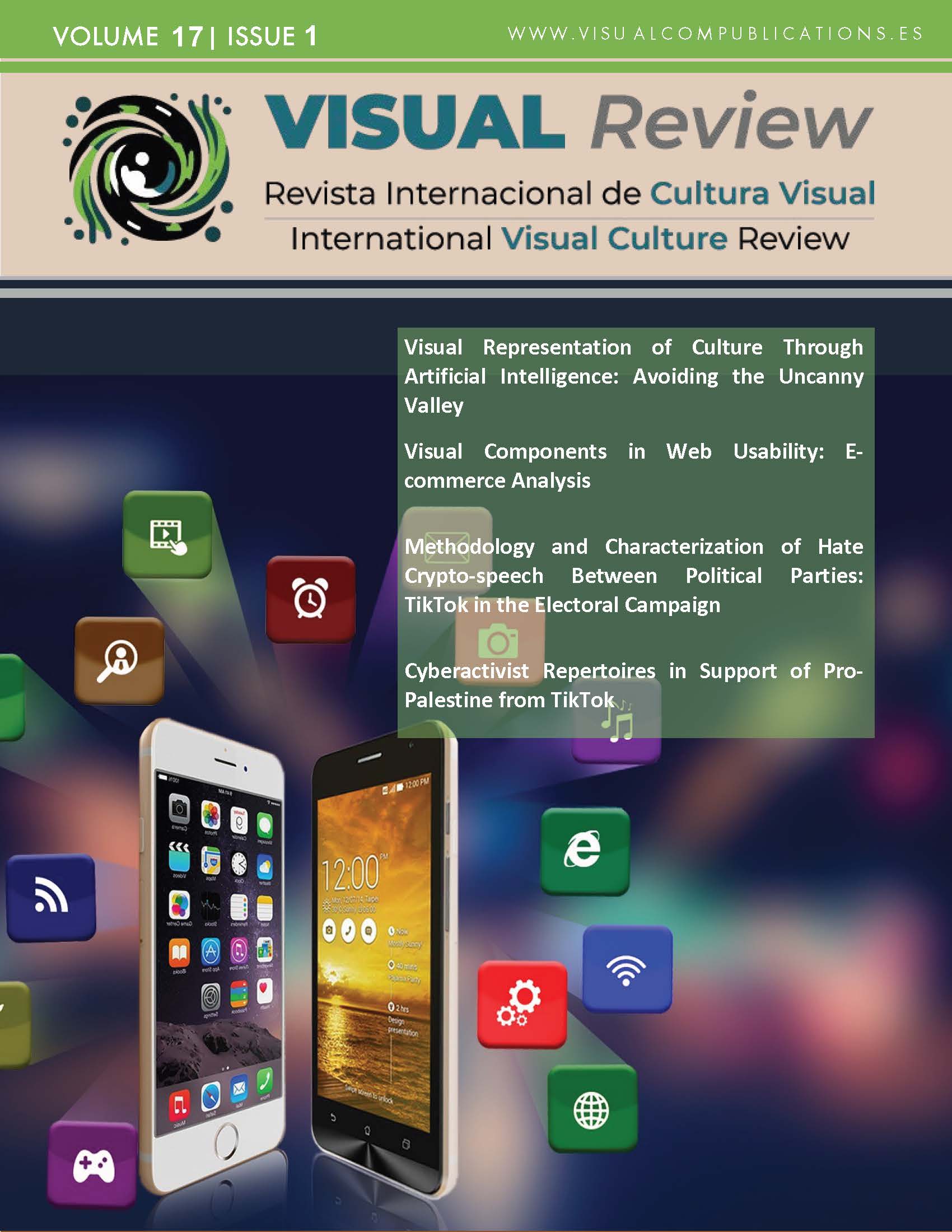Narrative Transformatios in the 5G Era
A Literature Review on the Development and Globalization of Chinese Web Series
DOI:
https://doi.org/10.62161/revvisual.v17.5324Keywords:
Chinese web series, Digital media, Cultural impact, 5G technology, Audience engagement, Systematic literature review (SLR)Abstract
This review paper systematically explores the significant evolution, and impact of Chinese's web series in the context of the rapid development of new media technology. The paper analyses the innovative production techniques and narrative developments enabled by 5G and digital streaming platforms. It reveals how web series have become a pivotal component of Chinese digital culture, reshaping entertainment consumption and offering new insights into the interactions between technology and media. Combining current trends and future technological innovations, this paper discusses the potential development trajectory of web series in China.
Downloads
Global Statistics ℹ️
|
767
Views
|
264
Downloads
|
|
1031
Total
|
|
References
Ashcraft, L. E., Quinn, D. A., & Brownson, R. C. (2020). Strategies for effective dissemination of research to United States policymakers: a systematic review. Implementation Science, 15, 1-17. DOI: https://doi.org/10.1186/s13012-020-01046-3
Atarama-Rojas, T., Guerrero-Pérez, E., & Gerbolini, V. (2020). Participation and Transmediality: Audience Influence on Web Series. International Journal of Communication, 14, 3614–3632.
Baber, H., & Fanea-Ivanovici, M. (2021). Motivations behind backers’ contributions in reward-based crowdfunding for movies and web series. International Journal of Emerging Markets, 18(3), 666–684. https://doi.org/10.1108/IJOEM-01-2021-0073 DOI: https://doi.org/10.1108/IJOEM-01-2021-0073
Blakney, P. (2020). Boutique branding: Televisual signifying the feminine business-owner. Television & New Media, 21(6), 600-615.
Boursier, V., Musetti, A., Gioia, F., Flayelle, M., Billieux, J., & Schimmenti, A. (2021). Is watching TV series an adaptive coping strategy during the COVID-19 pandemic? Insights from an Italian community sample. Frontiers in Psychiatry, 12, 599859. DOI: https://doi.org/10.3389/fpsyt.2021.698404
Burkholder, M., Ellingsen, S., Evans, N., & Turnbull, S. (2021). Web series, canceled, and the value of engagement. Participations, 18(2), 251-268.
Cao, L. (2023). New Media and Technology Convergence. In When Documentaries Meet New Media: Interactive Documentary Projects in China and the West (pp. 41-73). Berlin, Heidelberg: Springer Berlin Heidelberg. DOI: https://doi.org/10.1007/978-3-662-67406-2_3
Castro, D., Rigby, J. M., Cabral, D., & Nisi, V. (2021). The binge-watcher’s journey: Investigating motivations, contexts, and affective states surrounding Netflix viewing. Convergence, 27(1), 3-20. DOI: https://doi.org/10.1177/1354856519890856
Choat, S. (2018). Science, agency and ontology: A historical-materialist response to new materialism. Political Studies, 66(4), 1027-1042. DOI: https://doi.org/10.1177/0032321717731926
Chen, C. (2022). Research on iQIYI's suspense related online home-made dramas (2017-2021), (Master's thesis) Hebei Normal University.
Chen, Y. L. (2020). A narrative analysis of webisodes Love, Death and Robots from the perspective of Pierce's "Triad Combination" semiotics theory. World of Sound Screen, (09), 39-40.
Chen, S. X. (2024). From Traditional to Digital: Children’s Learning of Traditional Chinese Culture Through Festival-Related Storytelling. Event Management, 28(4), 549–565. https://doi-org.eresourcesptsl.ukm.remotexs.co/10.3727/152599523X16957834460240 DOI: https://doi.org/10.3727/152599523X16957834460240
China Internet Network Information Center. (2024). Statistical report on internet development in China (54th edition). China Internet Network Information Center. https://www.cnnic.net.cn/ n4/2024/0828/c208-11063.html
Christian, A. J. (2014). Indie TV: innovation in series development. In Media Independence (pp. 159-181). Routledge.
Cui, Y. F. (2020). “I am Yu Huanshui” A good play that is “short, precise and new”. Broadcasting Times Review, (Z5), 32-33.
Curtin, M. (2007). Playing to the world's biggest audience: The globalization of Chinese film and TV. Univ of California Press. DOI: https://doi.org/10.1525/9780520940734
Dai, Y. Q. (2020). The communication strategy of the short drama “I am Yu Huanshui” is analyzed by the 5W model. Audiovisual, (08), 63-64.
Deng, Z. N., & Xie, E. Q. (2020). What are the new trends in the drama market after the epidemic. China Radio and Television, (14), 63-65.
Di Giovanni, E. (2020). Reception studies and audiovisual translation. The Palgrave Handbook of Audiovisual Translation and Media Accessibility, 397-413. DOI: https://doi.org/10.1007/978-3-030-42105-2_20
Dhiman, D. B. (2023). Unleashing the Power of Television Broadcasting in the Digital Age: A Critical Review. Available at SSRN 4598192. DOI: https://doi.org/10.2139/ssrn.4598192
Dusi, N. (2016). Seriality, repetition, and innovation in Breaking Bad’s recaps and teasers. Cinergie–Il Cinema e le altre Arti, (10), 136-147.
Doyle, G., Paterson, R., & Barr, K. (2021). Television production in transition: Independence, scale, sustainability, and the digital challenge. Springer Nature. DOI: https://doi.org/10.1007/978-3-030-63215-1
García-Perdomo, V. (2021). Re-digitizing television news: The relationship between TV, online media, and audiences. Digital Journalism, 9(2), 136-154. DOI: https://doi.org/10.1080/21670811.2020.1777179
Gilardi, F., Lam, C., Tan, K. C., White, A., Cheng, S., & Zhao, Y. (2018). International TV series distribution on Chinese digital platforms: Marketing strategies and audience engagement. Global Media and China, 3(3), 213–230. https://doi.org/10.1177/2059436418806406 DOI: https://doi.org/10.1177/2059436418806406
Gilardi, F., & Lam, C. (2022). New perspective on UGC, PGC, and OGC: motivating factors of Chinese co-creators’ engagement with international television series. Creative Industries Journal, 1-16. DOI: https://doi.org/10.1080/17510694.2022.2150816
Gou, J. W., & Liu, Y. (2019). Introduction to new media marketing. Posts and Telecommunications Press.
Goodwin, J., Saab, M. M., Dillon, C. B., Kilty, C., McCarthy, A., O'Brien, M., & Philpott, L. F. (2021). The use of film-based interventions in adolescent mental health education: A systematic review. Journal of psychiatric research, 137, 158-172. DOI: https://doi.org/10.1016/j.jpsychires.2021.02.055
Grignaffini, G. (2016). Generi e rigenerazioni nella serialità Tv americana. Between, 6(11).
Hu, W. (2020). The key to the future of short plays depends on quality. China Press, Publication, Radio, and Television News, 003.
Huang, B. X. (2011). A Study on the Narrative Art of Chinese Web Drama. Nanjing University of the Arts.
Jain, S., & Kaur, K. (2020). YouTube content analysis using the case study method. Journal of Digital Media & Policy, 11(3), 295-310.
Jiang, F. (2019). Film and television channels and expressions of telling Chinese stories well under the new media environment — A case study of the webisodes Day and Night. Journalism Research Guide, (07), 83-84.
Jiang, R., Wang, L., & Tsai, S. B. (2022). An empirical study on digital media technology in film and television animation design. Mathematical Problems in Engineering, 2022(1), 5905117. DOI: https://doi.org/10.1155/2022/5905117
Joshi, A., & Dahiwal, N. S. (2021). Analysis of web series and movies using sentiment analysis. International Journal of Creative Research Thoughts, 9(7), 238-245.
Kackman, M., Binfield, M., Payne, M. T., Perlman, A., & Sebok, B. (Eds.). (2010). Flow TV: Television in the age of media convergence. Routledge. DOI: https://doi.org/10.4324/9780203879634
Kakkar, A., & Nayak, K. (2019). Analysis of product placement in web series and its influence on consumer buying behavior. Global Journal of Management And Business Research, 19(3), 21-27.
Kim, H. (2023). The Labor of Cultural Conception and Uncertainty in Cultural Work: The Work of Korean Drama Writers. International Journal of Communication, 18, 18.
Lee, C. K., & Yu, L. (2022). A multi-level perspective on 5G transition: The China case. Technological Forecasting and Social Change, 182, 121812. DOI: https://doi.org/10.1016/j.techfore.2022.121812
López-García, X., Pérez-Seijo, S., Vázquez-Herrero, J., & García-Ortega, A. (2020). New narratives in the age of visualization. Information Visualization in The Era of Innovative Journalism, 51-63. DOI: https://doi.org/10.4324/9780367809638-4
Li, F. (2020). The digital transformation of business models in the creative industries: A holistic framework and emerging trends. Technovation, 92, 102012. DOI: https://doi.org/10.1016/j.technovation.2017.12.004
Ma, L. L. (2014). A study on the characteristics of original online short drama communication subjects in media convergence. Drama House, (10), 159+167.
Ma, X. N. (2020). From I am Yu Huanshui to see the network breakout of urban short plays. Audio-visual industry, (6), 104-106.
Neuendorf, K. A. (2016). The content analysis guidebook. Sage. DOI: https://doi.org/10.4135/9781071802878
Niu, M. D., & You, H. (2020). Bid Kids fuels new trend of personalized drama viewing. China Today, (08), 76-77.
Patil, H. J., & Surwade, Y. P. (2018). Web technologies from web 2.0 to web 4.0. International Journal for Science and Advance Research in Technology, 4(4), 810-814.
Raphael, C. (2009). The political-economic origins of Reali-TV. In S. Murray & L. Ouellette (Eds.), Reality TV: remaking television culture, 2nd Edition. (pp. 123-140). New York: New York University Press.
Rizvic, S., Okanovic, V., & Boskovic, D. (2020). Digital storytelling. Visual Computing for Cultural Heritage, 347-367. DOI: https://doi.org/10.1007/978-3-030-37191-3_18
Sahu, G., Gaur, L., & Singh, G. (2021). Applying niche and gratification theory approach to examine the users’ indulgence towards over-the-top platforms and conventional TV. Telematics and Informatics, 65, 101713. DOI: https://doi.org/10.1016/j.tele.2021.101713
State Administration of Radio, Film, and Television. (2010). Regulations on the management of television drama content [Broadcast regulations]. Retrieved from https://www.gov.cn/gongbao/content/ 2010/content_1724816.htm
State Administration of Radio, Film, and Television. (2012). Notice on further strengthening the management of online dramas, microfilms, and other online audio-visual programs [Broadcast No. 53 of 2012].
State Administration of Radio, Film, and Television. (2014). Notice on strengthening the management of broadcast television programs, films, and online audio-visual program production and distribution.
State Administration of Press, Publication, Radio, Film, and Television. (2017). Notice on further strengthening the creation and broadcasting management of online audio-visual programs.
Statista. (2021). SVOD market in China. Retrieved from https://www.statista.com/study/106110/ subscription-video-on-demand-svod-in-china/
Sheng, Y.P. 2021. Research on the innovation and development of film and television industry in the 5G perspective. Media Forum.
Burkholder, M., Ellingsen, S., Evans, N., & Turnbull, S. (2021). Web series, cancelled, and the value of engagement. Participations, 18(2), 251-268.
Tang, X., & Zhang, X. (2017). The pragmatic analysis of the American TV series’ humorous dialogues based on the perspective of relevance theory—Take the example of the 2 Broke Girls. World Journal of Educational Research, 4(4). DOI: https://doi.org/10.22158/wjer.v4n4p594
Ulin, J. C. (2019). The business of media distribution: Monetizing film, TV, and video content in an online world. Routledge. DOI: https://doi.org/10.4324/9781351136624
Wang, A., Whyke, T. W., & Dean, L. (2023). The interplay between digital platforms and user-generated content in reinterpreting and recreating mythological narratives with traditional Chinese cultural elements: the animated series Yao-Chinese Folktales. Creative Industries Journal, 1–22. https://doi-org.eresourcesptsl.ukm.remotexs.co/10.1080/17510694.2023.2252423 DOI: https://doi.org/10.1080/17510694.2023.2252423
Wang, C., & Gao, Y. J. (2020). The Exploration of Chinese Web Dramas for Excellence: I am Yu Huanshui as an Example. Northern Media Research, (06), 53-56+60.
Wang, X. Y. (2022). An Analysis of the reasons for the popularity of suspense online dramas from the perspective of new media — taking iQIYI’s “Fog Theater” as an example. Western Radio and Television, (13), 127-129.
Wang, Y. (2019). Chinese television between propaganda and entertainment: socialist traditions, marketisation and popular TV dramas, 1992–2017 (Doctoral dissertation, Loughborough University).
Webster, J. G. (2014). The marketplace of attention: How audiences take shape in a digital age. MIT Press. DOI: https://doi.org/10.7551/mitpress/9892.001.0001
Williams, D. (2012). Web TV series: how to make and market them. Oldcastle Books.
Wong García, E., & Gómez Fernández, W. (2018). FANGS AND POWER: An analysis of discursive patterns of discrimination in the American TV series True Blood. Cogent Arts & Humanities, 5(1). DOI: https://doi.org/10.1080/23311983.2018.1423864
Wu, W. (2024). Application of Intelligent Algorithms and Big Data Analysis in Film and Television Creation. Scalable Computing: Practice & Experience, 25(3), 1882–1893. https://doi-org.eresourcesptsl.ukm.remotexs.co/10.12694/scpe.v25i3.2782 DOI: https://doi.org/10.12694/scpe.v25i3.2782
Wu, X. Y. (2020). On the value orientation and artistic innovation of suspense short play — A case study of Chinese first family suspense webisodes Bid Kids. World of Sound Screen, (19), 51-53.
Xiaying, X., & Hui, L. (Eds.). (2023). Chinese TV in the Netflix Era. Anthem Press.
Xiao, Q., & Li, X. L. (2012). Classic Textbook Series: Principles of Historical Materialism (3rd ed.).
Yalkin, C. (2021). TV series: marketplace icon. Consumption Markets & Culture, 24(2), 217-224. DOI: https://doi.org/10.1080/10253866.2019.1669569
Yang, H. B. (2020). The development of web sketches and content construction. Contemporary Television, (8), 91-94.
Yang, Z. (2020). Genre dramas are interesting, short dramas have breakthroughs, and boutique becomes mainstream: Observations on the web drama market in the summer of 2020. China Radio, Film and Television, (19), 38-41.
Yin, Y. (2016). An Analysis of Chinese Web Series Development and Strategy Go Princess Go: A Case Study (Doctoral dissertation, Drexel University).
Yin, Z. H., & Yun, M. (2013). Rhetorical devices in dialogues of The Big Bang Theory. Sino-US English Teaching, 9(6), 1220-1229.
Zhang, J. J., & Mastromartino, B. (2023). Transition from Traditional to Digital Strategies. In Digital Marketing in Sports (pp. 15-87). Routledge. DOI: https://doi.org/10.4324/9781003430353-3
Zhang, X. (2019). From Western TV sets to Chinese online streaming services: English-language TV series in mainland China. Participations: Journal of Audience and Reception Studies, 16(2), 220-242.
Zhang, S. (2023). An In Depth Study of Short Web Series in Mainland China-KuaiShou. Probe-Media and Communication Studies, 5(2).
Zhao, B. Z., & Lv, P. (2020). The Hibernation Period of Film and Television Workers - Reorganization of the Creative Ecosystem under the Epidemic. Sichuan Theatre.
Zhao, J. J. (2023). Queer TV China: Televisual and Fannish Imaginaries of Gender, Sexuality, and Chineseness. Hong Kong University Press. DOI: https://doi.org/10.5790/hongkong/9789888805617.001.0001
Zhao, Z. Y. (2017). Interpretation of postmodernist elements in new media films and television — A case study of webisodes Lady of the Extreme. News Research Guide, (11), 138
Downloads
Published
How to Cite
Issue
Section
License
Copyright (c) 2025 VISUAL REVIEW. International Visual Culture Review / Revista Internacional de Cultura Visual

This work is licensed under a Creative Commons Attribution-NoDerivatives 4.0 International License.
Those authors who publish in this journal accept the following terms:
-
Authors retain copyright.
-
Authors transfer to the journal the right of first publication. The journal also owns the publishing rights.
-
All published contents are governed by an Attribution-NoDerivatives 4.0 International License.
Access the informative version and legal text of the license. By virtue of this, third parties are allowed to use what is published as long as they mention the authorship of the work and the first publication in this journal. If you transform the material, you may not distribute the modified work. -
Authors may make other independent and additional contractual arrangements for non-exclusive distribution of the version of the article published in this journal (e.g., inclusion in an institutional repository or publication in a book) as long as they clearly indicate that the work was first published in this journal.
- Authors are allowed and recommended to publish their work on the Internet (for example on institutional and personal websites), following the publication of, and referencing the journal, as this could lead to constructive exchanges and a more extensive and quick circulation of published works (see The Effect of Open Access).













